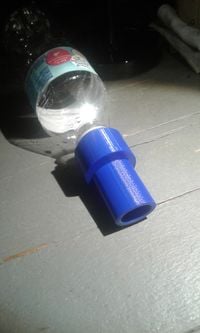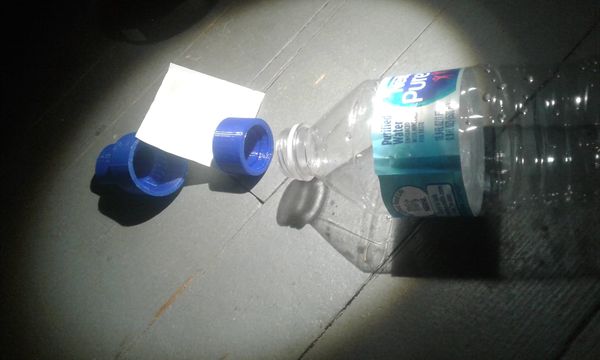| Line 41: | Line 41: | ||
|Image:BTJ_cap.png| Print bottle cap at .2mm layer height or less, with the threads at the top, without supports. Support material clogs up the threads, creating unnecessary cleanup work. Estimated print time at 70mm/s: 22 minutes. | |Image:BTJ_cap.png| Print bottle cap at .2mm layer height or less, with the threads at the top, without supports. Support material clogs up the threads, creating unnecessary cleanup work. Estimated print time at 70mm/s: 22 minutes. | ||
|Image:BTJ_holder.PNG| Print the tea bag holder as shown at .3mm layer height. Estimated print time at 70mm/s: 42 minutes. | |Image:BTJ_holder.PNG| Print the tea bag holder as shown at .3mm layer height. Estimated print time at 70mm/s: 42 minutes. | ||
|Image:BTJ_bag.jpg| Cut open at an edge and | |Image:BTJ_bag.jpg| Cut open a teabag at an edge and add one teaspoon activated carbon. | ||
|Image:BTJ_bag_holder.jpg| Stuff tea bag with carbon into the large end of the bag holder. | |Image:BTJ_bag_holder.jpg| Stuff tea bag with carbon into the large end of the bag holder. | ||
|Image:BTJ_cap_bottle.jpg| Screw cap onto bottle threads. | |Image:BTJ_cap_bottle.jpg| Screw cap onto bottle threads. | ||
Revision as of 02:51, 6 December 2018
Title of the device or system
Project developed by Benjamin Joseph Btjoseph (talk) 16:57, 5 December 2018 (PST)
Template:Statusboxtop Template:Status-design Template:Status-prototype You can help Appropedia by contributing to the next step in this OSAT's status. Template:Boxbottom
Abstract
Many developing third-world countries have a steady or increasing need for clean drinking water. Many solutions for achieving clean drinking water already exist, but require expensive manufacturing equipment outside the area where there is a need, and then incur shipping charges to ship them to the target location. 3D printing technologies allow rapid manufacture of humanitarian-aid devices such as water purification tools. This printable design requires some filament (preferable ABS), a tea bag, and activated carbon to create. This allows the user to drink filtered water on-demand from and standard plastic water or pop bottle.

Bill of Materials
- One bag holder: [STL] https://www.dropbox.com/s/m304isdsx3zttvk/bagHolder.stl?dl=0 [OpenSCAD] https://www.dropbox.com/s/8o9cin6t8afvpzx/bagHolder.scad?dl=0
- One bottle cap: [STL] https://www.dropbox.com/s/newoc354qbt4e34/bottle_cap.stl?dl=0 [OpenSCAD] https://www.dropbox.com/s/vygh1cng4045tv7/bottleCap.scad?dl=0( Bottle cap also required thread component: https://www.dropbox.com/s/xcsaov23rt63dbe/Thread_Library.scad?dl=0)
- One tea bag
- activated carbon ( about a teaspoon)
Costs
The activated carbon was obtained by cutting open a $6 Breta water filter (if bought in a six pack for $24) from Walmart. the carbon from one filter was able to fill 12 tea bags, making the carbon cost per bag $0.50. Activated carbon may likely be found cheaper than by using this method.
Tea bags are available from Walmart in 100-count boxes for $3.50, yielding a unit price of $0.04 if rounded up.
Cura estimates both parts will cost $0.51 to print.
Total cost: $0.50 + $0.04 + $0.51 = $1.05
Tools needed for fabrication of the OSAT
- MOST Delta RepRap or similar RepRap 3-D printer
- No other tools!
Technical Specifications and Assembly Instructions
Benefited Internet Communities
- Name and add links to at least 5 using single brackets around [url name]
References
- The sources of information (e.g. engineering handbooks, journal articles, government documents, webpages, books, magazine articles etc.). References should use the <ref> </ref> and <references/> tags and can be in any format but should include all the information necessary for someone else to find the same information you did. For example: [1]
- ↑ web page: Department of Energy (DOE) Landscaping and Energy Efficiency, DOE/GO-10095 (1995) Available: http://www.eren.doe.gov/erec/factsheets/landscape.html
Based on the developmental needs addressed (e.g. food, heat, electricity, clean water, health care, etc.) be sure to label your device in the proper categories e.g. use [[Category:Water]]. Be sure to categorize your device so that it will be easy to find – for example “Low voltage connection basics” is categorized in [[Category:How tos]] [[Category:Electricity]] [[Category:Electric lighting]].













